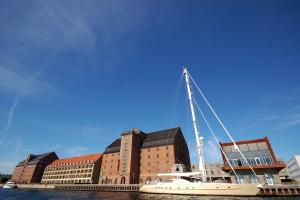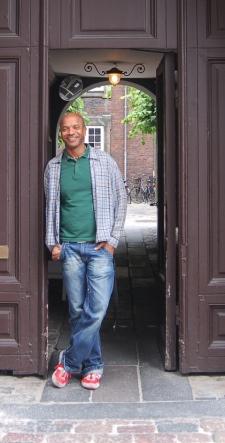
WALK THIS WAY. Copenhagen is a great walking city, with car-free streets and squares and expansive waterside boardwalks. Credit: David Walberg
At the end of July, tens of thousands of queers from every corner of the planet will descend on Copenhagen for the second World Outgames, a sports, culture and human rights extravaganza first held in Montreal three years ago.
This year’s festival brings a distinctly Danish twist to the proceedings, foregoing big arenas wherever possible and opening up the city’s beautiful parks, waterfronts, streets and public squares. “We try to get as far away from stadiums as possible and get a lot of activities out on the streets,” said Outgames’ CEO Uffe Elbaek, “It’s really something about human connections between people.”
“Denmark is known for being a very cozy place,” says Jakob Hougaard, one of the city’s two gay deputy mayors. “We have in Denmark a very egalitarian culture. Being on the eye level of other people, and being on the same boat — those are metaphors for Danish culture.”
Now’s your chance to mingle, not just with the Danes, but with gay athletes, artists, activists and tourists from all over. The games take place from Jul 25 until Aug 2. Late registration is open until Jul 1 for some events, but even if you’re not the competitive type, the Outgames provide a good backdrop for a visit to one of the world’s great gay cities.
If you’ve not visited the city before, think of Copenhagen as Amsterdam’s prettier, more sophisticated sister. While both cities prize relaxed and progressive living, cutting-edge design and insane amounts of partying, Amsterdam just can’t compete with Copenhagen’s superior bone structure. Amsterdam scores progressive points for its acceptance of drugs, prostitution and gay cruising, but Copenhagen’s elegant spires, broad parks and clean canals and harbour lift one’s spirits in a way that eludes even the haziest of Amsterdam’s coffeeshops. It also helps that Copenhagen is filled with friendly and attractive people.
We’ve assembled a survey of some highlights and tips to help you plan your visit. Check out our photo gallery and our past feature story on Copenhagen.
Outgames:
The Outgames sports division includes the usual disciplines of swimming, diving and track and field as well as winter events like ice hockey and figure skating and unexpected competitions in the gruelling bridge and billiards categories.
In the culture component, the worldwide Out Choir Festival will take place in the Tivoli amusement park’s famous Glass Concert Hall. The culture component also includes a Tango Festival, featuring some of the world’s greatest tango instructors and performers, and Out in Leather, a largely social program for BDSM enthusiasts.
Out Cities is a mini gay world’s fair, where a handful of cities showcase their queer cabaret singers, drag queens, DJs, bands and artists. Tel Aviv, Melbourne, Mexico City, Antwerp and Denmark’s second city Aarhus will be on display. The Out Cities exhibits are dotted across the heart of Copenhagen, organized along a route from the pretty HC Oersted Park through a selection of public squares and canal sites to Islands Brygge on the waterfront.
Two of the city’s major insitutions will showcase big gay-themed exhibits: Lost and Found at Nikolaj Copenhagen Center of Contemporary Art and The History of Homosexuality in Copenhagen at The Museum of Copenhagen.
The human rights conference, co-chaired by Canada’s Svend Robinson, brings together a compelling range of activists, from Nepal’s first openly gay MP to Georgina Beyer, the world’s first elected transsexual politician, who served as both a mayor and MP in New Zealand. Former NBA star John Amaechi of the US is a keynote speaker.
Attractions:
Hidden in dense greenery adjacent the water lies Christiania, the famous Copenhagen quarter that declared itself a free state in the 1970s and exists to this day as a social experiment in anarchy. “It’s a completely functional city in the city. It’s like the Vatican,” says Elbaek. Christiania has few rules of its own design and makes decisions collectively. The area has a wild, ramshackle vibe, with sprawling outdoor patios, spontaneous music and performances and makeshift DIY buildings covered in colourful graffiti. It’s a breezy contrast to the rest of the city’s tendency to tidy or sleek architecture and it exemplifies the Danes’ preoccupation with freedom and innovation and their corollary distaste for the normal.
The Tivoli amusement park contains rides, gardens, bars, restaurants and numerous performance venues. The site has the feel of an old-fashioned, leafy park and it was cleverly designed to feel intimate and quiet in most areas. The Tivoli’s outdoor stages host everything from puppet shows to big rock concerts. Its indoor venues include the Glass Concert Hall, destroyed by Nazi sympathizers during World War II and resurrected by renowned Danish modern designer and architect Poul Henningsen in 1946, and the Tivoli Concert Hall, a mid-century modern masterpiece.
Strøget, Europe’s longest pedestrian shopping street, begins modestly at the Town Hall Square. About ten minutes along, the shops become more interesting and soon the street transforms into a design district anchored by Danish design houses Georg Jensen, Royal Copenhagen and the department store Illums Bolighus.
A stroll on the lengthy boardwalk along the inner harbour takes you past Amalienborg Palace to any number of museums and galleries. Vestindisk Pakhus, home of the Royal Danish cast collection, houses thousands of plaster casts dating back to antiquity. A full-size replica of Michelangelo’s David stands out front. At the end of the boardwalk and the base of the Citadel park is the Gefion Fountain, an impressive depiction of the mythical Norse goddess Gefjun harnessing oxen to plow the land. According to myth, when Gefjun was promised as much land as she could plow in one night, she turned her four sons into oxen. The displaced earth was plowed into the sea, forming the island Zealand, where Copenhagen is located.
Parties:
In summer, the late night streets of central Copenhagen are one big party, where spirited patrons mingle and play as they hop from one bar to the next. Relations between straights and homos are entirely copasetic, and although the scene is seriously alcohol-fuelled and boisterous, there is none of the aggressive macho bullshit that makes straight club zones in North America and England so obnoxious.
When it comes to the regular gay scene, Oscar Bar Café is a central hub in the community. Situated around the corner from the city’s main square, Oscar is a charming café by day and a hopping gay bar by night. Dunkel is a mixed bar where men and women, straight and gay, drink and dance to the latest electro. Cozy Bar is a raucous late-night standby, in an area where the streets are dotted with gay and lesbian boîtes. Many bars stay open until the sun comes up. True to the city’s anarchic, can-do spirit, some of the more interesting parties are pulled together by groups of friends in one-off locations. The individual members of Dunst, a largely dissolved arts collective, stage parties with great music and wild performances. Check Copenhagen Gay Life for comprehensive and up-to-date details. The Outgames slate of parties are detailed on its website.
Getting around:
“Thirty-six percent of Copenhageners use their bicycle every day,” says gay deputy mayor Klaus Bondam. “Together with Amsterdam, we’re the only cities with these numbers.”
Visitors can take advantage of the city’s convenient coin-operated free bike programme. Drop in 20 Danish kroner (about $4) as a deposit, and you’ve got yourself a set of wheels. You’ll get your deposit back when you return the bike to one of more than a hundred racks around the city.
The city also has an efficient transit system, including a sleek new driverless subway.
Where to stay:
Admirers of mid-century Danish modern design will want to check out the SAS Radisson Royal Hotel. The legendary Arne Jacobsen designed the sleek hotel and produced some of his most iconic designs to furnish it. Enjoy a cocktail at the bar in an egg chair or a swan chair, or dine with the space-age AJ cutlery (so spacey it appears in the Stanley Kubrick film 2001: A Space Odyssey) in the penthouse restaurant.
For a more contemporary and affordable experience, The Square is a bright, airy hotel with modern but cozy rooms. Jacobsen egg chairs nest here, too; in crimson leather, they strike a sensual silhouette against stark white walls and clean, right angles. If this sounds like minimalist hotel hell, it’s not: the proportions are perfect and the effect, borne of Danish aesthetic expertise, is simply beautiful and pleasurable.
The Nimb Hotel provides the novelty of a stay inside the Tivoli Gardens amusement park in central Copenhagen. Other noteworthy hotels include Front, positioned near the harbour and Amalienborg Palace, and Hotel Skt Petri, built in a modern structure designed in 1920 as a department store.
Out of town:
The city of Malmö, Sweden is practically a part of Copenhagen since the opening of the Oresund Link, a long, sleek road and rail bridge across the Oresund Straight. Trains between the two cities generally run every 20 minutes. Malmö was a key market of the medieval Hanseatic League and the 13th century town centre is charming and well-preserved. The newer waterfront area features architect Santiago Calatrava’s famous Turning Torso tower and long boardwalks where scantily clad Swedes sun themselves. The friendly Café Banjo (at Falsterbogatan 22) is a good spot to get your bearings for queer activities in town.
Less than an hour’s drive from Malmo, the town of Ystad sits on Sweden’s sandy southern coast. The surrounding countryside is home to small, organic farms and businesses like Olof Viktors, a bakery and restaurant that patronizes the local farms. A scenic drive through the countryside can include stops at numerous country studios set up by artists and artisans, gay and straight, who are attracted to the area’s rolling hills.
My favourite discovery here was Kom I Luckan (or Come into the Fold, at Saltsjöbadsvägen 13, Ystad), a gay champagne bar in the middle of the woods. Friendly and flamboyant co-owners Joakim Bengtsson and Lolo Mårtensson have set up shop in a small kiosk, the kind one expects to serve up greasy fries and hot dogs. Instead, they pass fancy drinks in crystal glasses through their little window. The large, covered outdoor seating area is popular with residents of the traditional wooden summer houses nestled in the surrounding forest, as well as guests of the spa hotel Ystad Saltsjöbad, perched on the nearby beach. At the spa, you can lie by the beach or the pool, have a massage or float in the dark silence of a tranquility tank.
Resources:
World Outgames
Wonderful Copenhagen’s gay info
Visit Denmark’s gay info

 Why you can trust Xtra
Why you can trust Xtra


